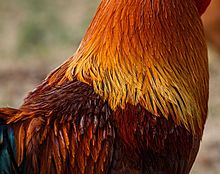
Vestigiality is the retention, during the process of evolution, of genetically determined structures or attributes that have lost some or all of the ancestral function in a given species. Assessment of the vestigiality must generally rely on comparison with homologous features in related species. The emergence of vestigiality occurs by normal evolutionary processes, typically by loss of function of a feature that is no longer subject to positive selection pressures when it loses its value in a changing environment. The feature may be selected against more urgently when its function becomes definitively harmful, but if the lack of the feature provides no advantage, and its presence provides no disadvantage, the feature may not be phased out by natural selection and persist across species.
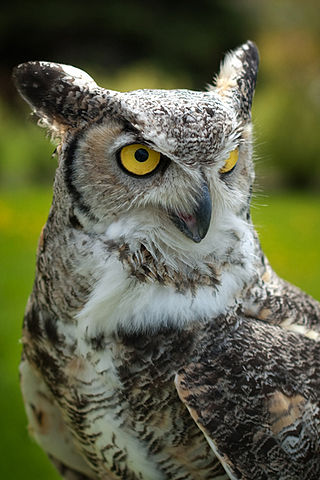
Ear tufts are a collection of fur or feathers found on animals which can resemble an animal's ear or is near the animal's ear.
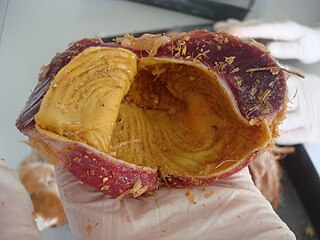
The gizzard, also referred to as the ventriculus, gastric mill, and gigerium, is an organ found in the digestive tract of some animals, including archosaurs, earthworms, some gastropods, some fish, and some crustaceans. This specialized stomach constructed of thick muscular walls is used for grinding up food, often aided by particles of stone or grit. In certain insects and molluscs, the gizzard features chitinous plates or teeth.

The hair follicle is an organ found in mammalian skin. It resides in the dermal layer of the skin and is made up of 20 different cell types, each with distinct functions. The hair follicle regulates hair growth via a complex interaction between hormones, neuropeptides, and immune cells. This complex interaction induces the hair follicle to produce different types of hair as seen on different parts of the body. For example, terminal hairs grow on the scalp and lanugo hairs are seen covering the bodies of fetuses in the uterus and in some newborn babies. The process of hair growth occurs in distinct sequential stages: anagen is the active growth phase, catagen is the regression of the hair follicle phase, telogen is the resting stage, exogen is the active shedding of hair phase and kenogen is the phase between the empty hair follicle and the growth of new hair.

A mixed breed is a domesticated animal descended from multiple breeds of the same species, often breeding without any human intervention, recordkeeping, or selective breeding. Examples include:

Goose bumps, goosebumps or goose-pimples are the bumps on a person's skin at the base of body hairs which may involuntarily develop when a person is tickled, cold or experiencing strong emotions such as fear, euphoria or sexual arousal.
The Delaware Blue Hen or Blue Hen of Delaware is a blue strain of American gamecock. Under the name Blue Hen Chicken it is the official bird of the State of Delaware. It is the emblem or mascot of several institutions in the state, among them the sports teams of the University of Delaware.

Cat anatomy comprises the anatomical studies of the visible parts of the body of a domestic cat, which are similar to those of other members of the genus Felis.
The arrector pili muscles, also known as hair erector muscles, are small muscles attached to hair follicles in mammals. Contraction of these muscles causes the hairs to stand on end, known colloquially as goose bumps (piloerection).

The nuchal ligament is a ligament at the back of the neck that is continuous with the supraspinous ligament.

Equine anatomy encompasses the gross and microscopic anatomy of horses, ponies and other equids, including donkeys, mules and zebras. While all anatomical features of equids are described in the same terms as for other animals by the International Committee on Veterinary Gross Anatomical Nomenclature in the book Nomina Anatomica Veterinaria, there are many horse-specific colloquial terms used by equestrians.

Cats communicate for a variety of reasons, including to show happiness, express anger, solicit attention, and observe potential prey. Additionally, they collaborate, play, and share resources. When cats communicate with humans, they do so to get what they need or want, such as food, water, attention, or play. As such, cat communication methods have been significantly altered by domestication. Studies have shown that domestic cats tend to meow much more than feral cats. They rarely meow to communicate with fellow cats or other animals. Cats can socialize with each other and are known to form "social ladders," where a dominant cat is leading a few lesser cats. This is common in multi-cat households.
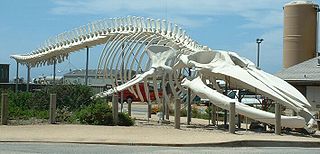
The largest body part is either the largest given body part across all living and extinct organisms or the largest example of a body part within an existing species. The largest animals on the planet are not the only ones to have large body parts, with some smaller animals actually having one particularly enlarged area of the body.

Cat behavior encompasses the actions and reactions displayed by a cat in response to various stimuli and events. Cat behavior includes body language, elimination habits, aggression, play, communication, hunting, grooming, urine marking, and face rubbing. It varies among individuals, colonies, and breeds.

The American Bantam Association is a poultry fancy association for breeders of bantam poultry. It publishes the Bantam Standard, with detailed descriptions of all the bantam breeds and varieties that it recognizes; in most – but not all – cases, these are the same as those recognised by the American Poultry Association. It also publishes a quarterly magazine and annual yearbook, hosts poultry shows and provides judges for them, and provides information on bantam breeds.
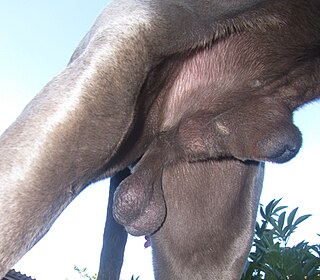
Almost all mammal penises have foreskins or prepuces, although in non-human cases, the foreskin is usually a sheath into which the whole penis is retracted. In koalas, the foreskin contains naturally occurring bacteria that play an important role in fertilization. In some bat species, the prepuce contains an erectile tissue structure called the accessory corpus cavernosum.

The hyoid apparatus is the collective term used in veterinary anatomy for the bones which suspend the tongue and larynx. It consists of pairs of stylohyoid, thyrohyoid, epihyoid and ceratohyoid bones, and a single basihyoid bone. The hyoid apparatus resembles the shape of a trapeze, or a bent letter "H". The basihyoid bone lies within the muscle at the base of the tongue.

Poultry feed is food for farm poultry, including chickens, ducks, geese and other domestic birds.

Long-crowing chicken breeds are characterised by the unusually long-drawn-out crow of the cocks, which may in some cases last for up to 60 seconds. The oldest references to long-crowing cocks are from China. Long-crowing breeds are found in the Far East, in Turkey, in the Balkans and in western Germany.
Gail Damerow is an American author and poultry expert. An Arizonan, she spent her adult life in various states, including Alaska, California, and finally Tennessee, where Damerow settled down on a farm with her husband in 1982. She spent much of her time raising farm animals and writing pieces about agriculture, farming, and similar topics in magazines and full length books she has published from the 1970s through the 2020s.
